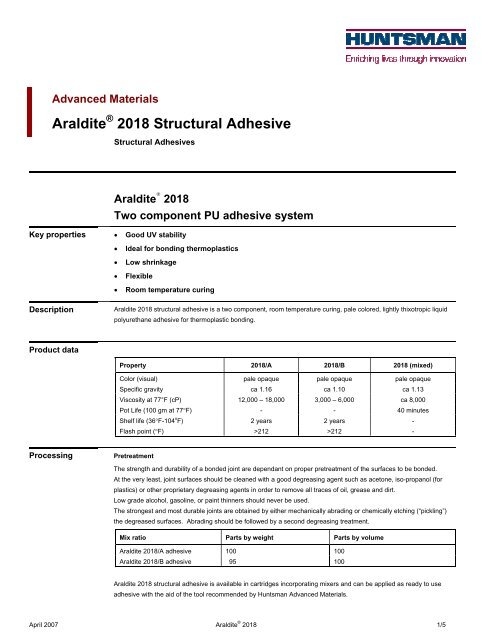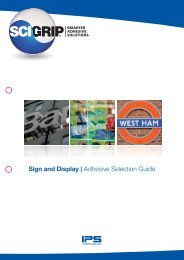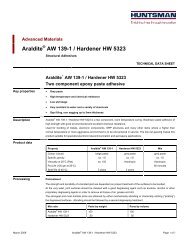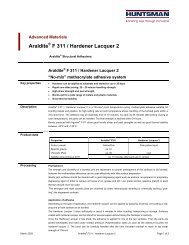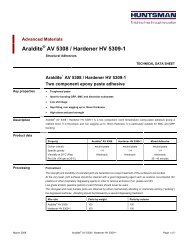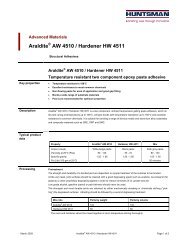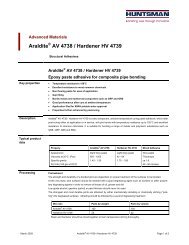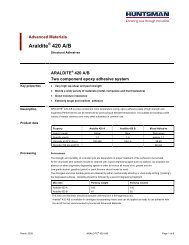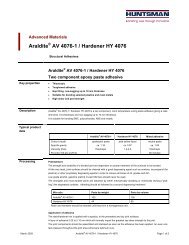TDS-Araldite 2018 - DanLube
TDS-Araldite 2018 - DanLube
TDS-Araldite 2018 - DanLube
You also want an ePaper? Increase the reach of your titles
YUMPU automatically turns print PDFs into web optimized ePapers that Google loves.
Advanced Materials<br />
<strong>Araldite</strong> ® <strong>2018</strong> Structural Adhesive<br />
Structural Adhesives<br />
<strong>Araldite</strong> ® <strong>2018</strong><br />
Two component PU adhesive system<br />
Key properties • Good UV stability<br />
• Ideal for bonding thermoplastics<br />
• Low shrinkage<br />
• Flexible<br />
• Room temperature curing<br />
Description<br />
<strong>Araldite</strong> <strong>2018</strong> structural adhesive is a two component, room temperature curing, pale colored, lightly thixotropic liquid<br />
polyurethane adhesive for thermoplastic bonding.<br />
Product data<br />
Property <strong>2018</strong>/A <strong>2018</strong>/B <strong>2018</strong> (mixed)<br />
Color (visual) pale opaque pale opaque pale opaque<br />
Specific gravity ca 1.16 ca 1.10 ca 1.13<br />
Viscosity at 77°F (cP) 12,000 – 18,000 3,000 – 6,000 ca 8,000<br />
Pot Life (100 gm at 77°F) - - 40 minutes<br />
Shelf life (36°F-104 o F) 2 years 2 years -<br />
Flash point (°F) >212 >212 -<br />
Processing<br />
Pretreatment<br />
The strength and durability of a bonded joint are dependant on proper pretreatment of the surfaces to be bonded.<br />
At the very least, joint surfaces should be cleaned with a good degreasing agent such as acetone, iso-propanol (for<br />
plastics) or other proprietary degreasing agents in order to remove all traces of oil, grease and dirt.<br />
Low grade alcohol, gasoline, or paint thinners should never be used.<br />
The strongest and most durable joints are obtained by either mechanically abrading or chemically etching (“pickling”)<br />
the degreased surfaces. Abrading should be followed by a second degreasing treatment.<br />
Mix ratio Parts by weight Parts by volume<br />
<strong>Araldite</strong> <strong>2018</strong>/A adhesive 100 100<br />
<strong>Araldite</strong> <strong>2018</strong>/B adhesive 95 100<br />
<strong>Araldite</strong> <strong>2018</strong> structural adhesive is available in cartridges incorporating mixers and can be applied as ready to use<br />
adhesive with the aid of the tool recommended by Huntsman Advanced Materials.<br />
April 2007 <strong>Araldite</strong> ® <strong>2018</strong> 1/5
Application of adhesive<br />
The resin/hardener mix may be applied manually or robotically to the pretreated and dry joint surfaces. Huntsman's<br />
technical support group can assist the user in the selection of a suitable application method as well as suggest a<br />
variety of reputable companies that manufacture and service adhesive dispensing equipment.<br />
A layer of adhesive 0.002 to 0.004 in (0.05 to 0.10 mm) thick will normally impart the greatest lap shear strength to the<br />
joint. Huntsman stresses that proper adhesive joint design is also critical for a durable bond. The joint components<br />
should be assembled and secured in a fixed position as soon as the adhesive has been applied.<br />
For more detailed explanations regarding surface preparation and pretreatment, adhesive joint design, and the dual<br />
syringe dispensing system, visit www.araldite2000plus.com<br />
Equipment maintenance<br />
All tools should be cleaned with hot water and soap before adhesives residues have had time to cure. The removal of<br />
cured residues is a difficult and time-consuming operation.<br />
If solvents such as acetone are used for cleaning, operatives should take the appropriate precautions and, in addition,<br />
avoid skin and eye contact.<br />
Times to minimum shear strength<br />
Temperature °F 50 59 73 104 140 212<br />
Cure time to reach hours 16 12 4 - - -<br />
LSS > 145 psi (1MPa) minutes - - - 45 25 4<br />
Cure time to reach hours 48 20 16 3 - -<br />
LSS > 1450 psi (10MPa) minutes - - - - 30 12<br />
LSS = Lap shear strength.<br />
Typical cured<br />
properties<br />
Unless otherwise stated, the figures given below were all determined by testing standard specimens made by lapjointing<br />
4.5 x 1 x 0.063 in (114 x 25 x 1.6 mm) strips of aluminum alloy. The joint area was 0.5 x 1 in (12.5 x 25 mm)<br />
in each case. The figures were determined with typical production batches using standard testing methods. They are<br />
provided solely as technical information and do not constitute a product specification.<br />
Average lap shear strengths of typical metal-to-metal joints (ISO 4587)<br />
Cured for 16 hours at 104°F (40 o C) and tested at 73°F (23 o C)<br />
Pretreatment - Sand blasting<br />
Substrate<br />
psi<br />
Aluminum 1015<br />
Steel 37/11 1160<br />
Stainless steel V4A 1015<br />
Galvanized steel 1523<br />
Copper 580<br />
Brass 653<br />
April 2007 <strong>Araldite</strong> ® <strong>2018</strong> 2/5
Average lap shear strengths of typical plastic-to-plastic joints (ISO 4587)<br />
Cured for 16 hours at 104°F and tested at 73°F. Pretreatment - Lightly abrade and alcohol degrease.<br />
Substrate<br />
psi<br />
GRP 1160<br />
CFRP 1204<br />
SMC 1015<br />
ABS 1001<br />
PVC 580<br />
PMMA 537<br />
Polycarbonate 899<br />
Polyamides 421<br />
Lap shear strength versus temperature (ISO 4587) (typical average values)<br />
Cure: (a) = 7 days / 73°F; (b) = 24 hours / 73°F + 30 minutes / 176°F<br />
4500 psi<br />
4000<br />
3500<br />
b<br />
3000<br />
2500<br />
a<br />
2000<br />
1500<br />
1000<br />
500<br />
0<br />
°F -76 -40 -4 32 68 104 140 176 212<br />
Roller peel test (ISO 4578)<br />
Cured 16 hours / 104 o F (40°C)<br />
23 pli (4.0 N/mm)<br />
Flexural Properties (ISO 178) Cure 16 hours/ 104 o F (40ºC) tested at 73 o F (23ºC)<br />
Flexural Strength<br />
Flexural Modulus<br />
215 psi (1.48 MPa)<br />
2321 psi (16 MPa)<br />
Elongation at break 45 %<br />
April 2007 <strong>Araldite</strong> ® <strong>2018</strong> 3/5
Lap shear strength versus immersion in various media (typical average values)<br />
Unless otherwise stated, L.S.S. was determined after immersion for 90 days at 73 o F (23°C)<br />
30 days 60 days 90 days<br />
Psi<br />
As-made value 0 0 1123<br />
IMS<br />
Degraded<br />
Gasoline (petrol) 1008 383 854<br />
Ethyl acetate<br />
Degraded<br />
Acetic acid, 10% 497 229 64<br />
Xylene 357 13 0<br />
Lubricating oil 843 599 1263<br />
Paraffin 1046 970 1263<br />
Water at 73°F 383 587 473<br />
Water at 140°F 508 435 363<br />
Water at 194°F 508 290 145<br />
Lap shear strength versus tropical weathering<br />
(40/92, DIN 50015; typical average values)<br />
Cure: 16 hours / 104 o F (40ºC); Tested at 73 o F (23ºC)<br />
psi<br />
As made value 1160<br />
After 30 days 402<br />
After 60 days 415<br />
After 90 days 566<br />
Lap shear strength versus heat ageing<br />
Cure: 16 hours / 104 o F (40 o C)<br />
psi<br />
As-made value 1073<br />
30 days/ 158°F 1958<br />
60 days/ 158°F 1784<br />
90 days/ 158°F 2611<br />
Thermal cycling<br />
100 cycles of 6 hour duration from -22°F to 158 o F (-30°C to 70°C): 1276 psi (8.8 MPa)<br />
April 2007 <strong>Araldite</strong> ® <strong>2018</strong> 4/5
Storage<br />
Handling<br />
precautions<br />
<strong>Araldite</strong> <strong>2018</strong>/A and <strong>Araldite</strong> <strong>2018</strong>/B structural adhesives may be stored for up to three years at room temperature<br />
provided the components are stored in sealed containers. The expiry date is indicated on the label. Cartridges should<br />
not be stored for long periods after removal from the foil overpack.<br />
Caution<br />
To protect against any potential health risks presented by our products, the use of proper personal protective<br />
equipment (PPE) is recommended. Eye and skin protection is normally advised. Respiratory protection may be<br />
needed if mechanical ventilation is not available or is insufficient to remove vapors. For detailed PPE<br />
recommendations and exposure control options consult the product MSDS or a Huntsman EHS representative.<br />
Huntsman Advanced Materials warrants only that its products meet the specifications agreed with the user. Typical properties, where stated, are to be<br />
considered as representative of current production and should not be treated as specifications.<br />
The manufacture of materials is the subject of granted patents and patent applications; freedom to operate patented processes is not implied by this<br />
publication.<br />
While all the information and recommendations in this publication are, to the best of Huntsman Advanced Material’s knowledge, information and<br />
belief, accurate at the date of publication, NOTHING HEREIN IS TO BE CONSTRUED AS A WARRANTY, WHETHER EXPRESS OR<br />
IMPLIED, INCLUDING BUT WITHOUT LIMIATION, AS TO MERCHANTABILITY OR FITNESS FOR A PARTICULAR PURPOSE. IN ALL<br />
CASES, IT IS THE RESPONSIBILITY OF THE USER TO DETERMINE THE APPLICABILITY OF SUCH INFORMATION AND<br />
RECOMMENDATIONS AND THE SUITABILITY OF ANY PRODUCT FOR ITS OWN PARTICULAR PURPOSE.<br />
Huntsman Advanced Materials<br />
10003 Woodloch Forest Drive<br />
The Woodlands, Texas 77380<br />
Tel: 888-564-9318<br />
Fax: 281-719-4047<br />
www.huntsman.com/advanced_materials<br />
The behaviour of the products referred to in this publication in manufacturing processes and their suitability in any given end-use environment are<br />
dependent upon various conditions such as chemical compatibility, temperature, and other variables, which are not known to Huntsman Advanced<br />
Materials. It is the responsibility of the user to evaluate the manufacturing circumstances and the final product under actual end-use requirements and<br />
to adequately advise and warn purchasers and users thereof.<br />
Products may be toxic and require special precautions in handling. The user should obtain Safety Data Sheets from Huntsman Advanced Materials<br />
containing detailed information on toxicity, together with proper shipping, handling and storage procedures, and should comply with all applicable<br />
safety and environmental standards.<br />
Hazards, toxicity and behaviour of the products may differ when used with other materials and are dependent on manufacturing circumstances or<br />
other processes. Such hazards, toxicity and behaviour should be determined by the user and made known to handlers, processors and end users.<br />
Except where explicitly agreed otherwise, the sale of products referred to in this publication is subject to the general terms and conditions of sale of<br />
Huntsman Advanced Materials LLC or of its affiliated companies including without limitation, Huntsman Advanced Materials (Europe) BVBA,<br />
Huntsman Advanced Materials Americas Inc., and Huntsman Advanced Materials (Hong Kong) Ltd.<br />
Huntsman Advanced Materials is an international business unit of Huntsman Corporation. Huntsman Advanced Materials trades through Huntsman<br />
affiliated companies in different countries including but not limited to Huntsman Advanced Materials LLC in the USA and Huntsman Advanced<br />
Materials (Europe) BVBA in Europe.<br />
<strong>Araldite</strong> is a registered trademark of Huntsman Corporation or an affiliate thereof in one or more, but not all, countries.<br />
Copyright © 2007 Huntsman Corporation or an affiliate thereof. All rights reserved.<br />
April 2007 <strong>Araldite</strong> ® <strong>2018</strong> 5/5


